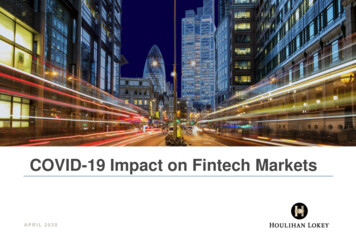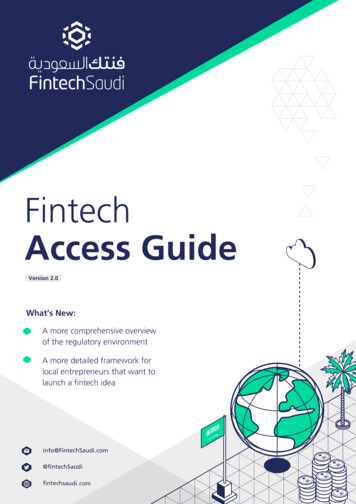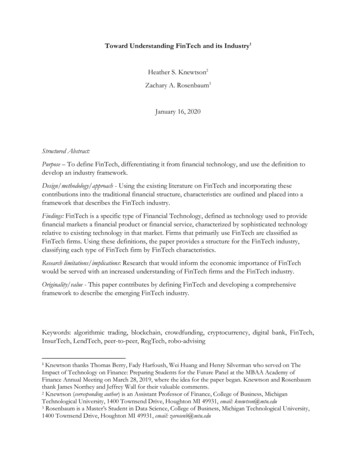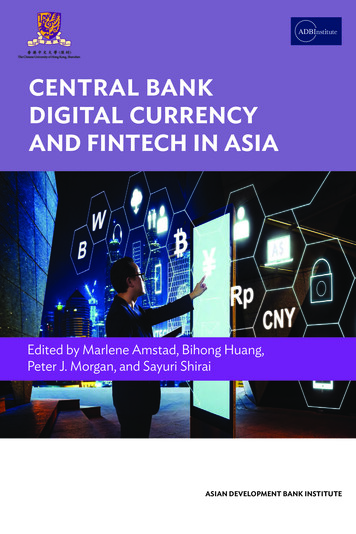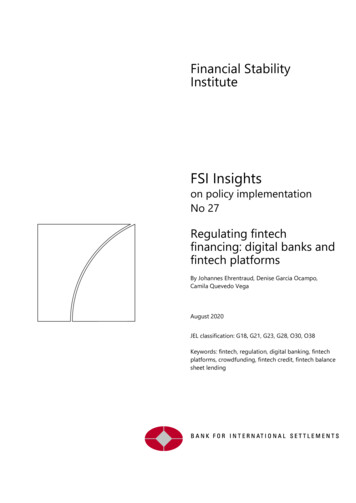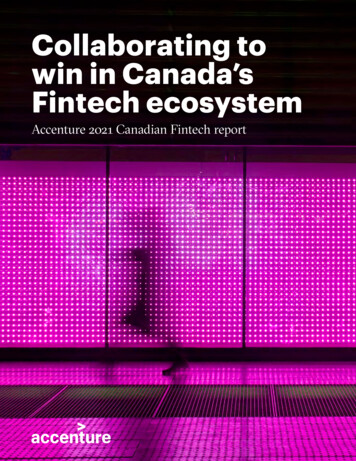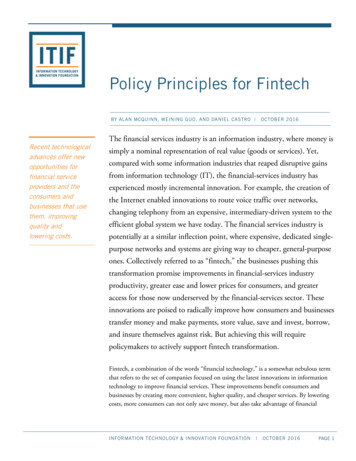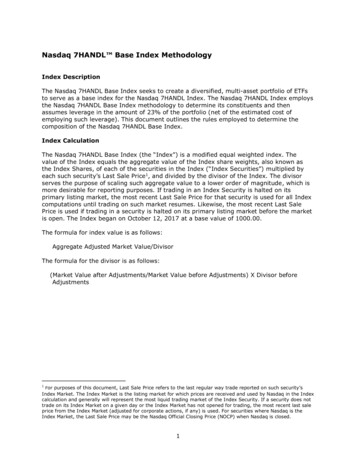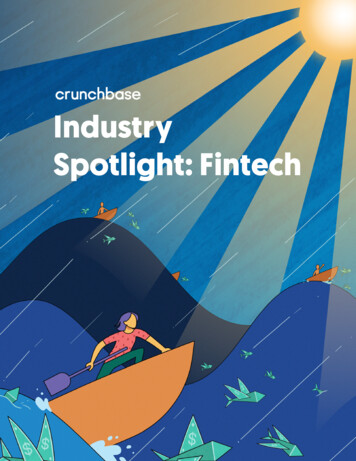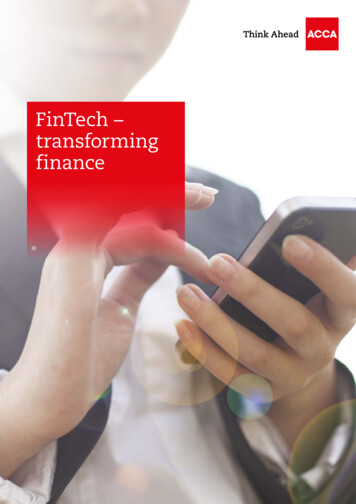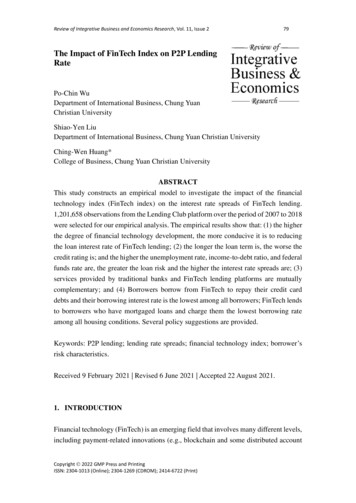
Transcription
Review of Integrative Business and Economics Research, Vol. 11, Issue 279The Impact of FinTech Index on P2P LendingRatePo-Chin WuDepartment of International Business, Chung YuanChristian UniversityShiao-Yen LiuDepartment of International Business, Chung Yuan Christian UniversityChing-Wen Huang*College of Business, Chung Yuan Christian UniversityABSTRACTThis study constructs an empirical model to investigate the impact of the financialtechnology index (FinTech index) on the interest rate spreads of FinTech lending.1,201,658 observations from the Lending Club platform over the period of 2007 to 2018were selected for our empirical analysis. The empirical results show that: (1) the higherthe degree of financial technology development, the more conducive it is to reducingthe loan interest rate of FinTech lending; (2) the longer the loan term is, the worse thecredit rating is; and the higher the unemployment rate, income-to-debt ratio, and federalfunds rate are, the greater the loan risk and the higher the interest rate spreads are; (3)services provided by traditional banks and FinTech lending platforms are mutuallycomplementary; and (4) Borrowers borrow from FinTech to repay their credit carddebts and their borrowing interest rate is the lowest among all borrowers; FinTech lendsto borrowers who have mortgaged loans and charge them the lowest borrowing rateamong all housing conditions. Several policy suggestions are provided.Keywords: P2P lending; lending rate spreads; financial technology index; borrower’srisk characteristics.Received 9 February 2021 Revised 6 June 2021 Accepted 22 August 2021.1. INTRODUCTIONFinancial technology (FinTech) is an emerging field that involves many different levels,including payment-related innovations (e.g., blockchain and some distributed accountCopyright 2022 GMP Press and PrintingISSN: 2304-1013 (Online); 2304-1269 (CDROM); 2414-6722 (Print)
Review of Integrative Business and Economics Research, Vol. 11, Issue 280technologies), technologies promoting personal and corporate payments (e.g., Venmo,Apple Pay, and Square), online alternative lending, and etc. Since 2010, onlinealternative lending has shown substantial growth. Online lenders have evolved from aplatform that connects individual borrowers with individual lenders to a complexnetwork that can characterize institutional investors, direct loans, and securitizationtransactions. The advancement of FinTech lending and the use of big data have changedthe way that consumers and small businesses secure financing. There are some signsthat it is beneficial for these alternative lenders to cooperate with banks. For example,Lending Club obtains some loans through WebBank.Some studies focus on issues related to FinTech lending, such as default rate(Emekter et al., 2015), herd behavior (Herzenstein et al., 2011), trust (Duarte et al.,2012), and social networks (Freemdan and Jin, 2014). Agrawal et al. (2013) illustratehow transaction costs, reputation, and market design explain the growth of FinTechlending from an economic point of view. A few studies discuss the role of FinTechlenders in expanding the availability of credit and allowing borrowers rejected bytraditional banks to obtain the funds they need. For example, Schweitzer and Barkley(2017) find that companies whose loans are rejected by banks have similarcharacteristics, and most of them turn to FinTech lending. Other FinTech surveys showthat the value of FinTech lenders can be enhanced through FinTech lending platforms. 1However, most of these documents rely on survey data and are subject to sampleselection biases and inconsistent response results. In addition, only a small number ofFinTech lenders make loan ratings public, which prevents researchers from drawingmore general and broader conclusions on the development of the FinTech industry.Recently, an emerging research topic is the interest rate setting mechanism ofFinTech lending. There are currently two mechanisms for determining the interest ratethat a borrower must pay from a P2P (peer-to-peer) lending platform, including thereverse auction process and the posted prices process. The reverse auction system issimilar to bond auctions where supply and demand determine interest rates. Potentialborrowers publish their loan applications on the platform, and investors bid at thecorresponding lowest interest rate during the auction. The Swiss P2P lending platformCashare has been using this auction process since its launch in 2008. Major participantsin the largest P2P lending markets in the U.S. and the U.K. also use the published priceprocess. In these models, the platform sets the interest rate for each loan list based onthe information available to the borrowers, which simplifies and shortens the process1For example, Desai and Meekings’ (2016) survey of Funding Circle finds that once the platform doesnot exist, 20% of borrowers will not be able to obtain external financing. A study by Ahmed et al. (2016)shows that nearly 35% of PayPal’s loans of working capital go to low-and-moderate-income businesses,while the retailed bank has only 21%.Copyright 2022 GMP Press and PrintingISSN: 2304-1013 (Online); 2304-1269 (CDROM); 2414-6722 (Print)
Review of Integrative Business and Economics Research, Vol. 11, Issue 281between the borrowers and the lenders (Chen et al., 2014).With the use of alternative data sources, big data, and mechanized learningtechnologies and algorithms and the application of artificial intelligence models,FinTech companies seem to be able to reduce credit decision-making, credit monitoringcosts and operating costs, thereby affecting the pricing of FinTech lending (measuredby interest rate spread). The financial technology index (FTI) developed by Hiemingaand Lande (2016) is to describe the environment and condition of a country’s financialtechnology development. It contains three different levels (i.e., demand, supply, andrisk) and thirteen component indicators and can be used to evaluate its impact on theFinTech lending rate.Other studies emphasize the importance of macroeconomic conditions indetermining the interest rates of FinTech loans (e. g., Bertsch et al., 2016; Lin and Wei,2016). Bertsch et al. (2016) confirm that the unemployment rate has a positive effecton borrowers' loan rates, and if the future economic conditions improve, it will lead toa decline in the FinTech loan rates. However, these studies ignore the stationarity ofmacroeconomic variables, which may lead to biased estimation results (Wu et al., 2016).The main purpose of this study is to construct a pricing model of FinTech lendingto estimate the impacts of the FinTech environment (measured by FTI), macroeconomicvariables (including stock return, federal funds rate, and unemployment rate), borrowerrisk characteristics (including credit rating scores, years of employment, and debt-toincome ratio (DTI)), and specific dummy variables (including borrower's housing status,loan term, loan purpose, and time dummy variables) on the interest rates of FinTechlending. Empirically, we select 1,201,658 observations from the Lending Club platformduring 2007-2018 for estimation. There are three reasons for this. First, Lending Clubis one of the few platforms that disclose its lending information. Second, Lending Clubis a larger and more mature platform in this field, so there will be more reference valuefor the empirical results. In addition, Lending Club provides loan-level data that coversdetail information about loans and borrowers instead of survey data.The rest of this study is organized as follows. Section 2 briefly reviews relevantliterature, including the impact of FinTech on obtaining credit and credit prices, as thebasis for establishing the empirical model of this study. Section 3 constructs the pricingmodel of FinTech lending, including three types of explanatory variables: borrower’scharacteristic variables, macroeconomic variables, and dummy variables, and thedependent variable of FinTech loan rate spreads. Section 4 introduces the related teststo ensure the availability and the soundness of the empirical results, includingcorrelation analysis to avoid the collinearity problem and unit root test to avoid thespurious regression problem. Section 5 reports the data source and empirical results,and the final section concludes the study and provides several policy suggestions.Copyright 2022 GMP Press and PrintingISSN: 2304-1013 (Online); 2304-1269 (CDROM); 2414-6722 (Print)
Review of Integrative Business and Economics Research, Vol. 11, Issue 2822. LITERATURE REVIEWSince the development time of financial technology lending is relatively short, there arefew quantitative estimation studies involved. In light of this, this section mainly reviewsthe literature in terms of the impact of FinTech on credit access and credit pricing asthe basis for establishing an empirical model.2.1. FinTech and LendingOnline FinTech lenders often use protective non-traditional information that is not usedin traditional bank’s loan decision-making and apply their own developed algorithmsfor lending. For example, develop online lending platforms and use big data to assessthe credit risk of borrowers. Using this new method of credit risk assessment, someconsumers can potentially increase the probability of the approval of credit applications.For example, some consumers with short credit history may not be able to meet the loanrequirements of traditional banks, but they can use alternative data sources (such asmobile phone data, rent payment records, electronic payments, insurance claims, bankaccount transaction records, and social network records, etc.) to establish credit recordsand increase credit information to obtain online loans. Frame et al. (2001) use telephonesurvey data of the top 200 large banks in the U.S. to examine the impact of emergingsmall business credit scores on lending behavior. The estimation results show that smallbusiness credit scores result in an increase in small business loans due to lowerinformation costs and information asymmetry between borrowers and lenders. Inaddition, the new algorithm of FinTech lenders expands lending activities to improveservices to consumers who previously received low loans.Online FinTech lenders rely more on other sources of information, such as salesinformation from Amazon, eBay, and other markets, shipping data from postal services,cash flow analysis and payment processors from business transaction checkingaccounts, and profitability analysis and prediction from social media. Crosman (2016)indicates that SoFi no longer uses FICO's scoring criteria as loan review conditions.Kabbage argues that FICO scores are not part of its credit review. The Prosper lendingplatform obtains 500 pieces of information from each borrower as a basis for creditevaluation; however, the FICO score responds just one piece of the information (i.e.,borrowers need to obtain at least 640 points to enter the loan consideration list). Inaddition, Mills and McCarthy (2014) find that Fundbox and Bluevine evaluate theborrower's information on QuickBooks, Xero, or FreshBooks when making loans. Theevaluation additionally uses an application program interface (API) to quickly obtainCopyright 2022 GMP Press and PrintingISSN: 2304-1013 (Online); 2304-1269 (CDROM); 2414-6722 (Print)
Review of Integrative Business and Economics Research, Vol. 11, Issue 283several financial records authorized by the borrower within a few seconds. Wack (2015)points out that PayPal and Square began to provide credit to some businesses based onthe sales data they obtained, and they are able to repay the loans directly from theincome of these businesses.Duarte et al. (2012), Gonzalez and Loureiro (2014), and Iyer et al. (2014) useProsper’s lending data to examine whether the characteristics of borrowers (e.g.,borrower’s appearance and verifiable network relationships) can affect loan success andloan rates. Iyer et al. (2014) find that lenders in the P2P lending market use softinformation to estimate borrower’s credit capability. Compared with credit scores, thismethod can predict the default rate more accurately, especially for borrowers with lowercredit ratings.2.2. FinTech lending and loan ratesIn addition to making consumers feel more convenient and faster, online alternativelending technology has provided better efficiency by reducing operating costs. Thus, itis important to examine whether FinTech lenders reflect lower lending costs onconsumers’ loan costs, and whether loan pricing reflects the risks taken. Some studieshave tried to compare the interest rates of P2P lending platforms and traditional loans,but they have been limited by significant data, and the results are ambiguous.Mach et al. (2014) use Lending Club's consumer loan data to explore loan rates forsmall businesses. It turns out that loan rates vary with the purpose of the loan, and thesebusiness loans are still subject to higher interest rates (consumer loans are used for smallbusiness purposes) even after controlling loan application conditions. In addition,comparing the loan rates of Lending Club and the National Federation of IndependentBusiness members, it is found that P2P small business loans will pay about twice theinterest rate of traditional borrowing channels. However, the small business loans inLending Club's consumer loan data do not represent traditional small business loansbecause these loans have a very small initial amount, are unsecured, and areunderwritten by consumers on the lending platform. Demyanyk and Kolliner (2014)use bankrate.com data and Lending Club's consumer loan rate to analyze the differencein the interest rates of credit cards. The results of the study find that consumers withgood credit can obtain preferential interest rates through FinTech lending than creditcards. However, these data cannot be directly compared in terms of loan levels. Emekteret al. (2015) use Lending Club data to discuss credit risk and loan rates. As generallyexpected, borrowers with low debt-to-income ratios have a lower risk of default.Charging higher interest rates for high-risk borrowers does not reduce the defaultprobability of loans.Copyright 2022 GMP Press and PrintingISSN: 2304-1013 (Online); 2304-1269 (CDROM); 2414-6722 (Print)
Review of Integrative Business and Economics Research, Vol. 11, Issue 284De Roure et al. (2016) compare the loan rates of the German P2P lending platform(Auxmoney) and Deutsche Bundesbank. It is found that after controlling the riskcharacteristics of borrowers, the loan rates of the P2P lending platform and traditionalbank are comparable. In addition, Buchak et al. (2017) study the rise of FinTech lendersand non-FinTech shadow banks in the housing loan market. Empirical data shows thatFinTech borrowers are among the borrowers who value fast and convenient services,while FinTech lenders require interest rate premiums for their services. Dietrich andWernli (2015) use data from Cashare (the largest participant in the Swiss P2P lendingmarket with a market share of nearly 98%) to analyze borrowers’ interest rates. Theempirical results find that borrowers have larger loan amounts or belong to homeownershave significantly lower loan rates, while female borrowers and those with higher debtto-income ratios have higher loan rates.Bertsch et al. (2016) use Prosper and Lending Club data to assess the impact ofmacroeconomic factors on cognitive default probability and personal loan interest rates.The empirical results show that even after controlling the characteristics of borrowersand loans, states with higher unemployment rates have higher loan rates. In addition, itis expected that future improvements in economic conditions (measured by changes inthe real yield curve) will lead to a decline in loan rates in the P2P lending market. Linand Wei (2016) use the Prosper platform to compare the auction-based model used byProsper before December 2010 with the posted-price model currently used. It turns outthat the interest rates allocated by the posted-price model are approximately 100 basispoints higher than those obtained by the auction-based model. In addition, loansgenerated by the posted-price model have a higher probability of default.In summary, the literature rarely estimates the determination of the FinTech lendingrates, especially the lack of assessing the impact of the FinTech developmentenvironment on the lending rates. Moreover, most of the previous studies ignore theimpact of macroeconomic variables on the lending rates, leading to biased estimationresults. In view of this, this study establishes a FinTech lending pricing model thatincludes variables such as FinTech index, borrower’s risk characteristics, andmacroeconomic conditions. This model not only highlights the role of FinTech indexand macroeconomic variables in FinTech lending rates but also provides importantinformation for FinTech borrowers, lenders, and the government to make relevantdecisions.3. EMPIRICAL MODELAccording to the literature above-mentioned, when evaluating FinTech lending rates,factors such as the development environment of financial technology, the riskCopyright 2022 GMP Press and PrintingISSN: 2304-1013 (Online); 2304-1269 (CDROM); 2414-6722 (Print)
Review of Integrative Business and Economics Research, Vol. 11, Issue 285characteristics of borrowers, and the macroeconomic environment should be consideredsimultaneously. Since Lending Club is not a traditional financial firm, it is unable toobtain complete financial information. In addition, considering its publicly availableinformation, this study establishes the following estimation equations to assess theimpact of macroeconomic environmental variables, borrower’s risk characteristics, andspecific dummy variables on the credit price of FinTech lending.IRSit α i β1 DTI it β 2YOEit β 3GTADEit β 4 SRt β 5 FFRt β 6U t β 7 FTI t h1 H 1 h2 H 2 h3 H 3 dtermTERM p1 P1 p2 P 2 ε it(1)The dependent variable ( IRSit ) represents the interest rate spread or the riskpremium of the FinTech lending rate, which is the difference between the FinTechlending rate and the risk-free interest rate measured by the interest rate of US Treasurybonds with the same maturity date.Regarding borrower’s risk characteristics, the debt-to-income ratio of the borrower( DTI it ) is used to measure the ability to repay; the length of borrower’s employment( YOEit ) is used to evaluate of borrower’s work stability and the repayment ability, andGTADEit represents the credit rating of borrowers from the best rating A to the worstrating G. Generally speaking, the lower the DTI it is, the stronger the borrower’stolerance would be; the longer the YOEit is, the lower the interest rate spread would be,and the better the GTADEit is, the lower the interest rate spread would be.In Eq. (1), the control factors that excessively influence credit demand, variablessuch as stock return ( SRt ), federal funds rate ( FFRt ), unemployment rate ( U t ), financialtechnology index ( FTI t ), and dummy variables are considered. Stock return representsthe prosperity and decline of the capital market, which in turn affects the wealth andrepayment behavior of borrowers. A rise in the stock market may have two differentshort-term effects on loan interest rates. First, it stimulates demand for loans, which inturn results in higher interest rates. Second, it causes the economy to overheat,triggering the central bank to use tight monetary supply to cool down. The federal fundsrate represents the short-term trend of monetary policy and is the reference fortraditional commercial banks to adjust interest rates. It is also an indicator for judgingthe competitive and complementary relationship between traditional commercial banksand FinTech lending. The unemployment rate is an important indicator for evaluatingeconomic prosperity, especially for developed countries. The higher the unemploymentrate of the overall economy, the greater the impact on the income and employment ofborrowers, and the greater the interest rate spread would be. The FinTech indexconstructed by Hieminga and Lande (2016) includes comprehensive indicators of theurgency of financial technology, financial technology infrastructure, financialtechnology ecosystem, and political and regulatory environment. In theory, the higherCopyright 2022 GMP Press and PrintingISSN: 2304-1013 (Online); 2304-1269 (CDROM); 2414-6722 (Print)
Review of Integrative Business and Economics Research, Vol. 11, Issue 286the FinTech index is, the lower the risk of FinTech lending and the smaller the riskpremium (the interest rate spread in this study) would be.In terms of dummy variables, Hi, i 1,2,3 are dummy variables, representing theborrower’s home ownership status, including own homes (H1 H2 H3 0), homemortgage (H1 1 and H2 H3 0), rental housing (H2 1 and H1 H3 0), and others(H3 1 and H1 H2 0). TERM is a dummy variable, TERM 1 means the loan term is5 years, and TERM 0 means the loan term is 3 years. The liquidity premium theorystates that the longer the maturity is, the higher the interest rate would be, and the marketsegmentation theory argues that the interest rate is determined by the supply anddemand of the individual loan terms (Cox et al., 1985). Pi, i 1,2 are dummy variables,representing different loan purposes: repaying credit cards (P1 P2 0), performing debtconsolidation (P1 1 and P2 0), and other purposes (P2 1 and P1 0 ).4. EMPIRICAL RESULTS4.1. DataEmpirically, this study uses 1,201,658 observations of Lending Club during the periodof 2007-2018 for estimation. The loan information includes specific information aboutthe loan (i.e., loan interest rate), borrower's risk characteristics (i.e., credit rating, lengthof employment, DTI, and home ownership status), and other risk characteristics (i.e.,loan term and loan purpose). This study focuses analysis on consumer loans forrepayment of credit cards and debt consolidation because these loans account for morethan 85% of Lending Club's overall consumer loans. Regarding the macroeconomicvariables, stock return (S&P 500 index return rate, SR), federal funds rate (FFR), andunemployment rate (U) are used.Hieminga and Lande (2016) construct a FinTech index covering three dimensionsof demand, supply, and risk, which further includes four comprehensive indicators: theurgency of financial technology, financial technology infrastructure, financialtechnology ecosystem, and the political and regulatory environment. Wu et al. (2020)reconstruct the index by deleting the incomplete data of the reliability of the grid. Inmeasuring the development environment of financial technology, this study adopts theFTI constructed by Wu et al. (2020).The data sources and measurements of the variables used in this study are shownin Table 1.Copyright 2022 GMP Press and PrintingISSN: 2304-1013 (Online); 2304-1269 (CDROM); 2414-6722 (Print)
Review of Integrative Business and Economics Research, Vol. 11, Issue 287Table 1 Data source and �s riskvariablesInterest rate spreadThe difference between the loan(IRS)interest rate and the risk-free interestLending Club,Taiwanrate (i.e. U.S. Treasury bond interestEconomicrate) (%).Journal (TEJ)Debt-to-incomeBorrower’s total debt repayment /Lending Clubratio (DTI)borrower’s monthly income (%)Years ofIt ranges from 0.5 to 10 years, ofemployment (YOE)which less than 1 year is set to 0.5Lending Clubyears, and more than 10 years to 10years.Credit ratingThe ranking from best to worst is A to(GRADE)G, A is set to 1, and so on, G is set toLending Club7.Home ownershipH1 H2 H3 0 represents thatstatus (H1, H2, H3)borrowers have own homes; H1 1Lending Cluband H2 H3 0 mean that borrowershave mortgage loans; H2 1 andH1 H3 0 indicate that borrowers arerenters, and H3 1 and H1 H2 0represent that borrowers belong toother home ownership status.Loan purpose (P1,P1 P2 0 means loans for repayingP2)credit cards; P1 1 and P2 0 meansLending Clubloans for debt consolidation, andP2 1 and P1 0 means loans for otherpurposes.Loan term (TERM)TERM 0 means a 36-month loan, andLending ClubTERM 1 means a 60-month loan.MacroeconomicvariablesS&P500 return rateA representative stock market return(SR)in the U.S. (%)Federal Funds rateA representative short-run interest rate(FFR)in the U.S. (%)Unemployment rateDatastreamDatastreamDatastream(U)FinancialSee Wu et al. (2020)technology index(FTI)Copyright 2022 GMP Press and PrintingISSN: 2304-1013 (Online); 2304-1269 (CDROM); 2414-6722 (Print)Wu et al. (2020)
Review of Integrative Business and Economics Research, Vol. 11, Issue 288Before conducting the empirical estimation and analysis, the descriptive statisticsof the variables are presented in Table 2 to understand their basic characteristics. TheDebt-to-income ratio has the largest standard deviation (15.092) among the borrower’srisk characteristic variables, and the credit rating has the smallest one (1.2477). TheFinancial technology index (FTI) has the largest standard deviation (6.1690) among themacroeconomic variables, and the unemployment rate has the smallest one (0.6994),meaning that FTI is the most volatile among the macroeconomic variables. Except forthe YOE, SP, and FTI, the remaining variables have positive a skewness coefficient,showing a right-skewed distribution. Except for YOE and FFR, the remainder has akurtosis coefficient larger than 3, revealing a leptokurtic distribution. Among them, thedebt-to-income ratio has the highest value (1627.8), implying that the data is highlyconcentrated on the mean. In addition, the test statistics for normal distribution (JarqueBera) all significantly reject the null hypothesis of a normal distribution, meaning thatnone of the variables belongs to a normal distribution.Table 2 Descriptive statisticsPanel (A)Borrower’s risk 001.0000Std. .14730.6262Kurtosis3.57601627.821.40883.1576J-B statistic1459932.36E economic 555Std. .6805-0.6279Kurtosis5.10291.89793.08003.9611J-B 000.00000.0000Panel (B)Note: The dummy variables are not included in the table.Copyright 2022 GMP Press and PrintingISSN: 2304-1013 (Online); 2304-1269 (CDROM); 2414-6722 (Print)
Review of Integrative Business and Economics Research, Vol. 11, Issue 2894.2. Empirical resultsTo avoid the use of highly linearly correlated macroeconomic variables for regression,this study performs correlation analysis, and the correlation coefficients between allmacroeconomic variables are lower than 0.45. Besides, according to the results of thenonlinear unit root test in Table 3, the t-value and F-value of the four macroeconomicvariables are significantly different from zero, meaning that these variables belong tostationary series.Table 3 Nonlinear unit root test-Emirmahmutoglu and Omay (2014)Variableast 8383*8.4662***FTI2.8774***4.1962***Notes: the lag length of the testing equations is determined by the minimum value of SIC (Schwarzinformation criterion). *** and * indicate the significance level of 1% and 10% according to the p valueof sieve bootstrap.The estimation results of Eq. (1) are shown in Table 4, and the importantconclusions are summarized as follows.Borrower’s risk characteristicsFirst, debt-to-income ratio (DTI) has a positive and significant effect on FinTechlending rate spread, revealing that when the borrower has a higher DTI, the loan defaultrisk is also higher, resulting in a higher FinTech loan interest rate. Second, years ofwork (YOE) have an insignificantly negative impact on FinTech lending rate spread.The reason is that the borrower with higher seniority and average salary has more strongrepayment ability and a lower default probability, which leads to a lower loan interestrate. Third, borrowers with existing mortgage loans (H1 1 and H2 H3 0) have a lowerloan rate than borrowers with their own homes (H1 H2 H3 0). The possible reason isthat they have collaterals for guarantee; therefore, the default risk is low. Borrowersbelonging to renters (H1 H3 0 and H2 1) have a significantly higher loan rate thanborrowers having own homes (H1 H2 H3 0) because they lack substantial collateral.Moreover, borrowers belonging to other home ownership status (H1 H2 0 and H3 1)Copyright 2022 GMP Press and PrintingISSN: 2304-1013 (Online); 2304-1269 (CDROM); 2414-6722 (Print)
Review of Integrative Business and Economics Research, Vol. 11, Issue 290have an insignificant impact on the loan rate because this kind of borrowers is quitecomplicated. Fourth, the longer the loan term (TERM) is, the higher the default risk ofthe FinTech platform and the platform’s loan rate would be. Fifth, borrowers to performdebts consolidation (P1 1 and P2 0) have a higher loan rate than borrowers to repaythe debts of credit cards (P1 P2 0) because they have a complicated risk. Borrowersto perform other purposes (P1 0 and P2 1) are more difficult to grasp, so the loan rateis higher than that of borrowers to repay the debts of credit cards (P1 P2 0). Finally,the impact of the credit rating (GRADE) on FinTech loan rates is positive andsignificant, implying that when the borrower's credit rating is poor, the defaultprobability and loan rate are high.Table 4 Estimation result of FinTech lending rate spreadVariableCoefficientStandard errorP .04000.0
lending. Empirically, we select 1,201,658 observations from the Lending Club platform during 2007-2018 for estimation. There are three reasons for this. First, Lending Club is one of the few platforms that disclose its lending information. Second, Lending Club is a larger and more mature platform in this field, so there will be more reference value


